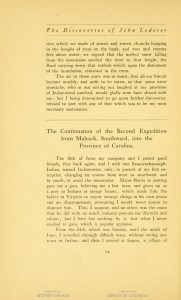
Lederer, John. The discoveries of John Lederer, in three several marches from Virginia to the west of Carolina, and other parts of the continent: begun in March, 1669, and ended in September, 1670, together with a general map of the whole territory which he traversed. [Charleston, S.C., Walker, Evans & Cogswell Co, 1891] Accessed October 8. https://lccn.loc.gov/rc01002786.
In this journal, John Lederer recounts his discoveries and observations during his 1670 exploration of parts of Virginia and North Carolina that were not yet settled by Europeans. During his exploration, Lederer came across several Native American towns and tribes, including the Occaneechi Indians—a tribe that lived on an island near present-day Clarkesville, Virginia before moving south to Orange County. [1] In his journal, Lederer vividly recounts the time when during his exploration, “all our Biscuit became mouldy and unfit to be eaten, so that some nicer stomachs, who at our setting out laughed at my provision of Indian-meal parched, would gladly now have shared with me.” [2] Later in his journal, he clarifies that he was eating parched corn, which is a portable and high-energy food made by roasting corn.
While it is unclear which tribe gave Lederer the provisions, we can assume that each tribe in the areas near Virginia and North Carolina was eating a similar food that was able to withstand getting stale or moldy on long journeys in the humid southern air. This parched corn serves as an example of the ways Indians were able to use food to support their lifestyles in the environments in which they lived. The Occaneechi Indians were often on the move, as they were a large part of the fur and deerskin trade that occurred between Europeans residing in Virginia and the Piedmont tribes. [1] Also, when they were driven out of Virginia after being attacked during Bacon’s Rebellion, they needed a food source to sustain them on the journey to present-day Orange County. [1] The flexibility and dependability of the food they ate allowed them to make these moves and set up trade that had large impacts on North Carolina, Orange County, and even Chapel Hill.
Lederer’s journal raises another point that is significant to the Chapel Hill food story, but also to the food story of America in general. While Europeans were exploring and colonizing America, they had to admit to the fact that some Indian practices were better suited to the new environment than their own ways. Lederer had the realization that while biscuits were suitable for life back home in Europe, they were less dependable in the new environment of America. This acceptance of new ways of eating shows just one example of adaptations colonials made to adjust to a new life in a new place. Were it not for these adjustments, the outcome of Europeans on this continent could have ended quite differently. Chapel Hill was therefore impacted by the European adoption of food practices used by Piedmont Native Americans for hundreds of years prior to their arrival.
[1] Dickens, Roy, H. Trawick Ward, and R.P Stephen Davis, Jr. Excavating Occaneechi Town: Archaeology of an Eighteenth-Century Indian Village in North Carolina. [Research Laboratories of Archaeology at the University of North Carolina at Chapel Hill, 2003]. Accessed October 8. https://rla.unc.edu/dig/html/part2/tab0.html
[2] Lederer, John. The discoveries of John Lederer, in three several marches from Virginia to the west of Carolina, and other parts of the continent: begun in March, 1669, and ended in September, 1670, together with a general map of the whole territory which he traversed. [Charleston, S.C., Walker, Evans & Cogswell Co, 1891] Accessed October 8. https://lccn.loc.gov/rc01002786.
Maggie Emery